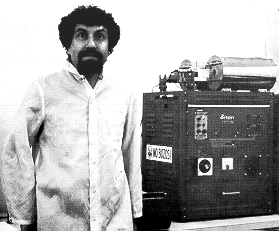As part of the festivalCHAT2020 I wrote about the Pompeii Premise and impermanence. I also made another post where I set out my own sort-of historiography of early thinking about time in archaeology. I think they help situate the lead up to the “Pompeii Premise” Debate between Binford and Schiffer (of whom this post is largely about).

Image: "The Temple of Isis, Pompeii. Date: c1870 by Giorgio Sommer." by brit_robin is marked with CC PDM 1.0
The Debate over a Pompeii Premise
In an earlier post wrote about how the Pompeii premise was first referenced in a footnote of American Robert Ascher’s 1961 paper. He wrote that a Pompeii premise is an “erroneous notion, often implicit in archaeological literature”[1] where the interpreting archaeologist actually construes the record as “the remains of a once living community, stopped as it were, at a point in time.” It’s all in the name: the Pompeii premise assumes that any archaeological site is an exact snapshot of a moment in time, just as the Roman city was captured in it’s moment of ultimate destruction. It was this term—Pompeii premise—that Michael Brian Schiffer would use to describe the New Archaeology (Processualism).
Burnt by Schiffer
Disapproving of the statement made by Lewis Binford[2] that different tasks leave a “fossil” record, Schiffer published a paper in 1972 (a year before attaining his doctoral thesis) that outlined his flow models and refuse labels. Four years later, in his book Behavioral Archaeology[3], Schiffer claimed that the new archaeology was operating with an attitude associated with the ‘Pompeii premise’ just as Ascher[4] had proposed in 1961.

Image: Photograph of Michael B Schiffer
Binford’s Clap Back
Schiffer’s accusation prompted Binford to respond in his paper, Behavioral Archaeology and the “Pompeii Premise”. Binford clapped back that Schiffer had “completely distorted the past … with his failure to appreciate an important formation process (successional use) as a possible contributor to his “recovery context” materials.”[5] Four years after Binford published his paper, critiquing behavioural archaeology and accusing Schiffer of wanting to find Pompeii himself,[6] Michael Schiffer revisited the ‘Pompeii premise’ again with a focus on the American Southwest[7]

Image: Photograph of the late Lewis Binford
Schiffer’s Snapback Clap Back
“The real Pompeii premise,” Schiffer wrote, is “a methodological tenet of the New Archaeology.”[8] While he does end up clarifying that both he and Binford agree that “most sites are not little Pompeii’s”, he concludes that the choice that archaeologists make on the ways that they treat assemblage variability profoundly affects both the character and reliability of claims made about prehistory. While Schiffer’s paper was clap back repaid to Binford, I think that Schiffer failed to address the fundamental critique that Binford had made on the distortion of the record—that the “archaeological record is not distorted with respect to its own reality, but only relative to an archaeologist’s preexisting expectations.”[9]
My Take
To me it feels a bit awkward reading this debate between the two men. There’s seems to be very little humility to go around. But this popularised, confrontational and bitter public debate between the two was fundamental (at least in an English-speaking, Eurocentric context) to position discussions on time conceptualisations in archaeology. The debate established a place for addressing things around time, of scale, and processes in the archaeological discourse. I think its more than possible that the contradictory scales at which Schiffer and Binford look at the archaeological the record is where the differences in their approach truly come to light. Simply put by Lucas,[10]
“… where Binford sees an irresolvable palimpsest suggesting that the systemic context actually needs to be studied at a larger temporal scale, Schiffer see the challenge as dissecting the palimpsest to understand the small-scale events that produced it.”
I think with most things in life we tend to find what we’re looking for. The questions we ask always shape the kinds of answers we are going to get, and the things we prize most are the things that often the things that end up monopolising our attention (just like the things we wish to avoid the most end up being hard to escape from). I feel that looking at the wrong scale in archaeology just leads us to a place where we can't see the forest for the trees. Without understanding the scale of time we wish to investigate, we can’t ask the right questions and, as a result, we can’t apply the right theory, methodology, or techniques. I write more about scale in one of my posts for the festivalCHAT and I also wrote about the Pompeii premise and the Law of Impermanence for the series. Those posts use art to conceptualise ways of thinking about time in archaeology. Other posts in the same series, the Drift of Time, use forms of poetic expression to aid in conceptualisations of time!
Footnotes
[4] Ascher 1961, p. 324 [5] Binford 1981, p. 204 [6] Binford 1981, p. 201 [7] Schiffer 1985 [8] Schiffer 1985, p. 38) [9] Binford 1981, p. 200 [10] Lucas 2012, p. 103
References
Ascher, R. 1961, ‘Analogy in Archaeological Interpretation’, Southwestern Journal of Anthropology, vol. 17, pp. 317–325.
Binford, L R 1964, ‘A Consideration of Archaeological Research Design’, American Antiquity, vol. 29, pp. 425–441.
Binford, L R 1981, ‘Behavioral Archaeology and the “Pompeii Premise”’, Journal of Anthropological Research, vol. 37, no. 3, pp. 195–208.
Lucas, G 2012, Understanding the Archaeological Record, Cambridge University Press, Cambridge.
Schiffer, M B 1976, Behavioral Archaeology, Academic Press, New York.
Schiffer, M B 1985, ‘Is There a “Pompeii Premise” in Archaeology?’, Journal of Archaeological Research, vol. 41, no. 1, pp. 18–41.